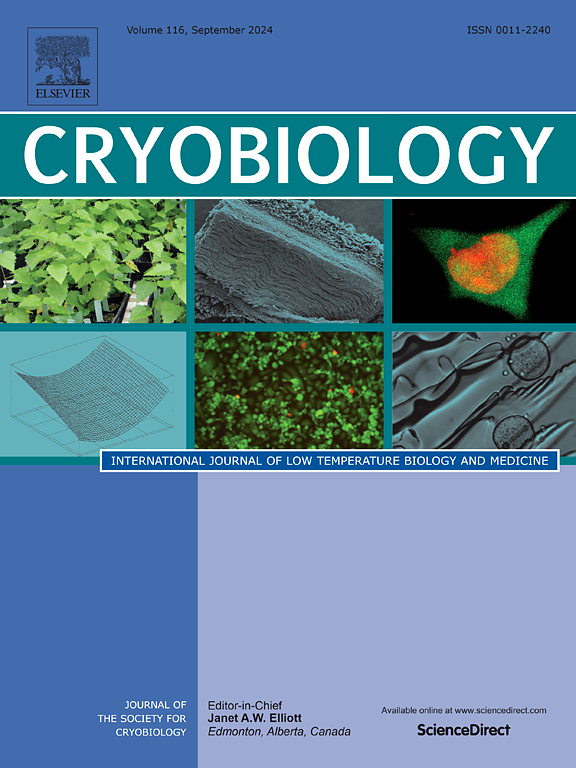Comparison of different freezing rates on post-thaw viability, proliferation, and stemness of sheep spermatogonial stem cells
IF 2.1
3区 生物学
Q2 BIOLOGY
引用次数: 0
Abstract
The application of spermatogonial stem cells (SSC) will be more effective and feasible following the successful cryopreservation and transfer of SSCs in livestock. Like other cells, SSCs are also sensitive to cryoinjury; hence composition of the cryomedia and freezing protocols need to be optimized. The present study aims to optimize the best freezing rates by minimising the ice crystallization and dehydration effect in order to maximize the post-thaw SSCs survivability and stemness characteristics. Three different freezing protocols with varied cooling profiles, cooling profile 1 (isopropanol based freezing): 1 °C/min from 0 °C to −10 °C, 0.5 °C/min up to −40 °C, further reduced to 0.25 °C/min up to −50 °C and 0.1 °C/min to −60 °C; cooling profile 2 (using programmable freezer): 1 °C/min up to 4 °C, 0.3 °C/min up to −8 °C, and cooled at 0.5 °C/min to −50 °C, further decrease to −90 °C (8 °C/min) and cooling profile 3 (uncontrolled rapid freezing): 3.3 °C/min from 0 °C to −10 °C, 5 °C/min up to −40 °C, 2 °C/min to −50 °C and 1.2 °C/min up to −60 °C, were compared for cryopreservation efficiency. The overall viability (91.41 ± 2.00 % Vs 74.59 ± 2.34 %), stemness activity (1.34 ± 0.095 OD units Vs 0.356 ± 0.026 OD units), and proliferation rate (0.849 ± 0.019 OD units Vs 0.749 ± 0.015 OD units) of post-thaw SSC culture irrespective of the freezing regimes were significantly decreased when compared to pre-freeze SSC culture characteristics. The post-thaw viability was significantly greater in cooling profile 1 (79.64 ± 4.1 %) when compared to cooling profile 2 (69.72 ± 2.4 %) and cooling profile 3 (75.43 ± 4.8 %). Also, cooling profile 1 yielded greater (p < 0.05) post-thaw stemness activity (0.456 ± 0.044 OD units) when compared to other methods. The study suggests that the cooling profile 1 using isopropanol based freezing can be recommended for preservation of viability and stemness characteristics of SSCs.
不同冷冻速率对绵羊精原干细胞解冻后活力、增殖和干性的影响。
精子干细胞的低温保存和移植将使其在家畜体内的应用更加有效和可行。与其他细胞一样,ssc对低温损伤也很敏感;因此,需要对低温培养基的组成和冷冻方案进行优化。本研究旨在通过最大限度地减少冰结晶和脱水效应来优化最佳冷冻速率,以最大限度地提高解冻后SSCs的存活率和干性特征。三种不同的冷冻方案具有不同的冷却配置,冷却配置1(基于异丙醇的冷冻):1°C/分钟从0°C到-10°C, 0.5°C/分钟到-40°C,进一步降低到0.25°C/分钟到-50°C和0.1°C/分钟到-60°C,冷却配置2(使用可编程冷冻机):1°C/分钟到4°C, 0.3°C/分钟到-8°C,冷却在0.5°C/分钟到-50°C,进一步降低到-90°C(8°C/分钟)和冷却配置3(不受控制的快速冷冻):在0°C至-10°C、5°C/min至-40°C、2°C/min至-50°C和1.2°C/min至-60°C范围内进行低温保存效率比较。与冷冻前相比,解冻后SSC培养的总体活力(91.41±2.00% Vs 74.59±2.34%)、茎干活性(1.34±0.095 OD单位Vs 0.356±0.026 OD单位)和增殖率(0.849±0.019 OD单位Vs 0.749±0.015 OD单位)显著降低。降温模式1的融后活力(79.64±4.1%)显著高于降温模式2(69.72±2.4%)和降温模式3(75.43±4.8%)。此外,冷却剖面1产生了更大的(p)
本文章由计算机程序翻译,如有差异,请以英文原文为准。
求助全文
约1分钟内获得全文
求助全文
来源期刊

Cryobiology
生物-生理学
CiteScore
5.40
自引率
7.40%
发文量
71
审稿时长
56 days
期刊介绍:
Cryobiology: International Journal of Low Temperature Biology and Medicine publishes research articles on all aspects of low temperature biology and medicine.
Research Areas include:
• Cryoprotective additives and their pharmacological actions
• Cryosurgery
• Freeze-drying
• Freezing
• Frost hardiness in plants
• Hibernation
• Hypothermia
• Medical applications of reduced temperature
• Perfusion of organs
• All pertinent methodologies
Cryobiology is the official journal of the Society for Cryobiology.
 求助内容:
求助内容: 应助结果提醒方式:
应助结果提醒方式:


